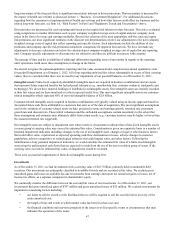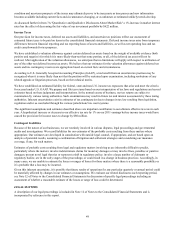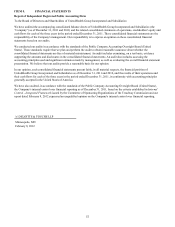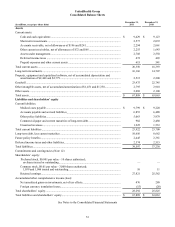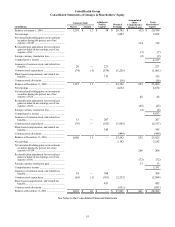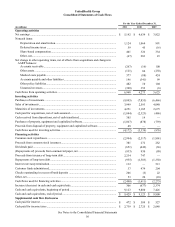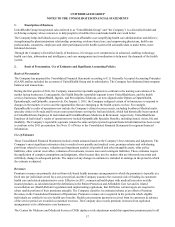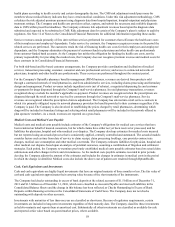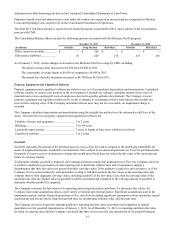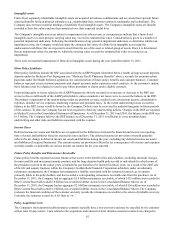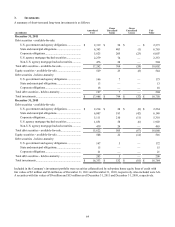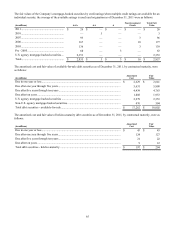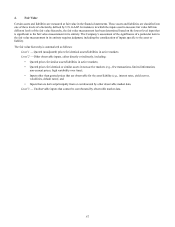United Healthcare 2011 Annual Report Download - page 59
Download and view the complete annual report
Please find page 59 of the 2011 United Healthcare annual report below. You can navigate through the pages in the report by either clicking on the pages listed below, or by using the keyword search tool below to find specific information within the annual report.57
UNITEDHEALTH GROUP
NOTES TO THE CONSOLIDATED FINANCIAL STATEMENTS
1. Description of Business
UnitedHealth Group Incorporated (also referred to as “UnitedHealth Group” and “the Company”) is a diversified health and
well-being company whose mission is to help people live healthier lives and make health care work better.
The Company helps individuals access quality care at an affordable cost; simplifying health care administration and delivery;
strengthening the physician/patient relationship; promoting evidence-based care; and empowering physicians, health care
professionals, consumers, employers and other participants in the health system with actionable data to make better, more
informed decisions.
Through the Company's diversified family of businesses, it leverages core competencies in advanced, enabling technology;
health care data, information and intelligence; and care management and coordination to help meet the demands of the health
system.
2. Basis of Presentation, Use of Estimates and Significant Accounting Policies
Basis of Presentation
The Company has prepared the Consolidated Financial Statements according to U.S. Generally Accepted Accounting Principles
(GAAP) and has included the accounts of UnitedHealth Group and its subsidiaries. The Company has eliminated intercompany
balances and transactions.
During the first quarter of 2011, the Company renamed its reportable segments to conform to the naming conventions of its
market facing businesses. Consequently, the Health Benefits reportable segment is now UnitedHealthcare, and the health
services businesses, OptumHealth, Ingenix, and Prescriptions Solutions, are now aligned under Optum as OptumHealth,
OptumInsight, and OptumRx, respectively. On January 1, 2011, the Company realigned certain of its businesses to respond to
changes in the markets it serves and the opportunities that are emerging as the health system evolves. For example,
OptumHealth’s results of operations now include the Company’s clinical services assets, including Southwest Medical multi-
specialty clinics in Nevada and Evercare nurse practitioners serving the frail and elderly, which had historically been reported
in UnitedHealthcare Employer & Individual and UnitedHealthcare Medicare & Retirement, respectively. UnitedHealthcare
Employer & Individual’s results of operations now include OptumHealth Specialty Benefits, including dental, vision, life and
disability. The Company’s reportable segments remain the same and prior period segment financial information has been recast
to conform to the 2011 presentation. See Note 13 of Notes to the Consolidated Financial Statements for segment financial
information.
Use of Estimates
These Consolidated Financial Statements include certain amounts based on the Company’s best estimates and judgments. The
Company’s most significant estimates relate to medical costs payable and medical costs, premium rebates and risk-sharing
provisions related to revenues, valuation and impairment analysis of goodwill and other intangible assets, other policy
liabilities, other current receivables, valuation of investments, income taxes and contingent liabilities. These estimates require
the application of complex assumptions and judgments, often because they involve matters that are inherently uncertain and
will likely change in subsequent periods. The impact of any changes in estimates is included in earnings in the period in which
the estimate is adjusted.
Revenues
Premium revenues are primarily derived from risk-based health insurance arrangements in which the premium is typically at a
fixed rate per individual served for a one-year period, and the Company assumes the economic risk of funding its customers'
health care and related administrative costs. Effective in 2011, commercial health plans with medical loss ratios on fully
insured products, as calculated under the definitions in the Patient Protection and Affordable Care Act and its related
reconciliation act (Health Reform Legislation) and implementing regulations, that fall below certain targets are required to
rebate ratable portions of their premiums annually. The Company classifies its estimated rebates as an offset to Premium
Revenues in the Consolidated Statement of Operations. Premium revenues are recognized in the period in which eligible
individuals are entitled to receive health care benefits. Health care premium payments received from its customers in advance
of the service period are recorded as unearned revenues. The Company also records premium revenues from capitation
arrangements at its collaborative care businesses.
The Centers for Medicare and Medicaid Services (CMS) deploys a risk adjustment model that apportions premiums paid to all


